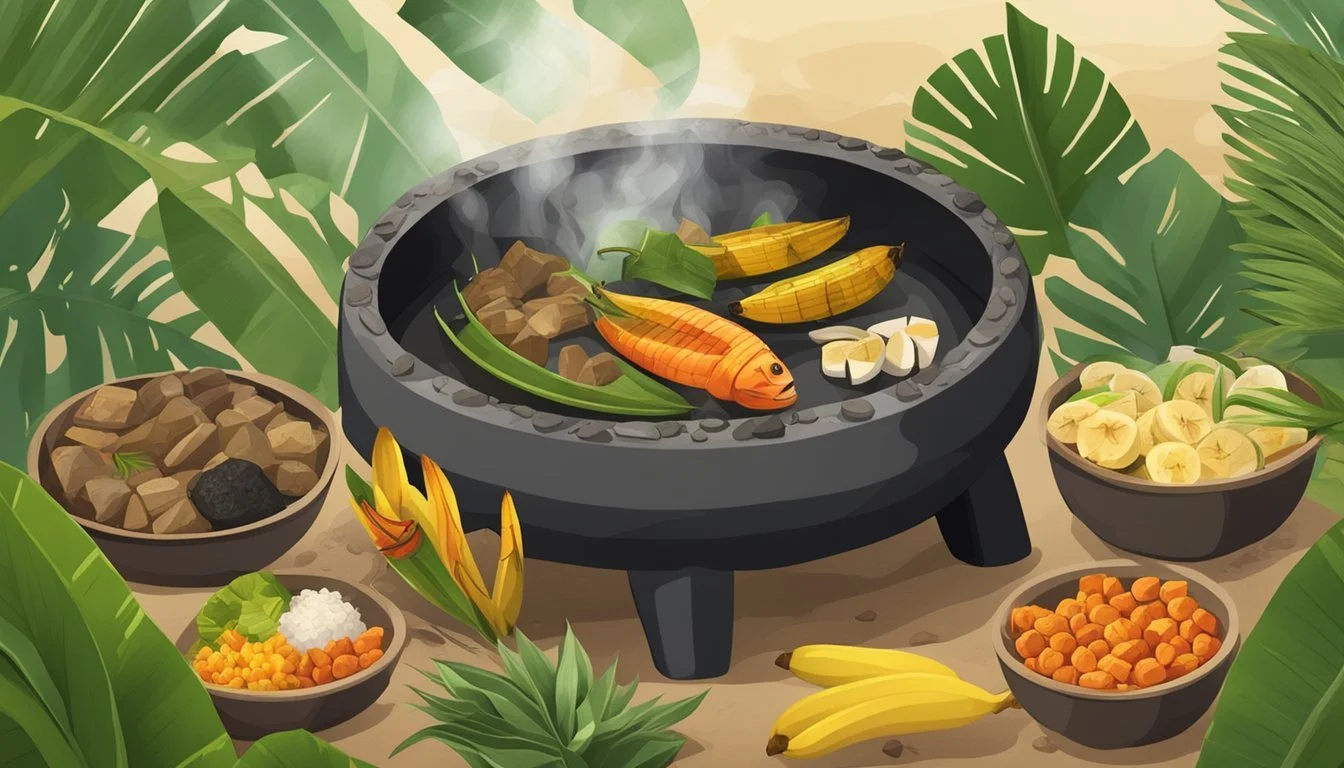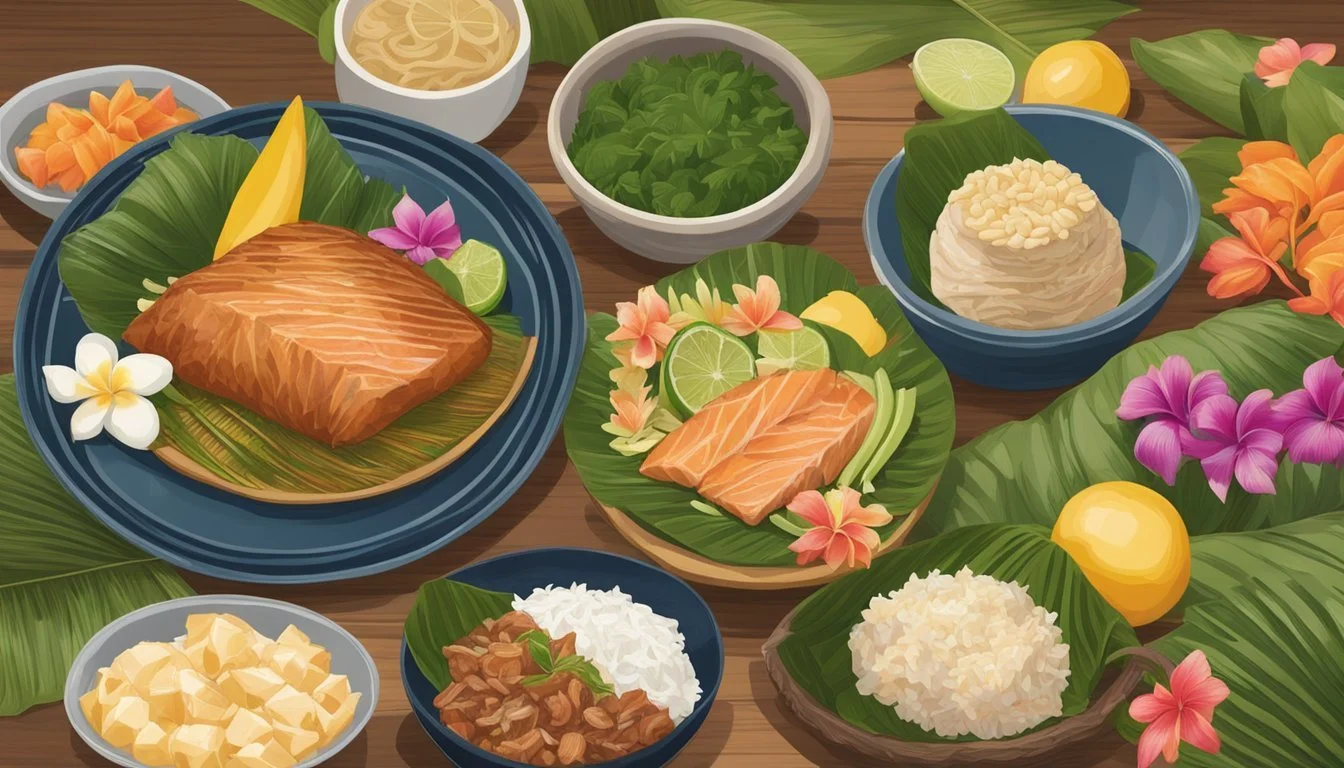Cooking Hawaiian Style
Authentic Island Flavors and Techniques
Hawaiian cuisine blends diverse cultural influences with local ingredients to create uniquely flavorful dishes. From kalua pork to poke bowls, Hawaiian cooking embraces both traditional techniques and modern innovations. Cooking Hawaiian Style combines fresh island produce, seafood, and tropical flavors into satisfying meals that capture the essence of paradise.
Recipes like lomi lomi salmon, laulau, and haupia showcase Hawaii's culinary heritage while adapting to contemporary tastes. Many dishes incorporate staples like taro, coconut, pineapple, and macadamia nuts. Hawaiian home cooks and professional chefs alike put their own creative spins on classic favorites passed down through generations.
Exploring Hawaiian recipes allows cooks to bring a taste of the islands to their own kitchens. Whether preparing a luau feast or weeknight dinner, Hawaiian-style cooking offers accessible ways to experience the warm hospitality and rich food traditions of Hawaii. Online resources and cooking shows provide inspiration for recreating authentic island flavors at home.
Historical Context of Hawaiian Cuisine
Hawaiian cuisine has deep roots stretching back to the ancient Polynesian settlers who arrived on the islands between 300 and 800 AD. These early inhabitants brought with them staple crops like taro, coconuts, and sugarcane.
Taro played a central role in traditional Hawaiian food culture. The root vegetable was cultivated in terraced fields called lo'i and pounded into poi, a smooth paste that accompanied many meals.
The arrival of European explorers in the late 18th century marked a significant shift in Hawaiian foodways. New ingredients and cooking methods were introduced, gradually altering the culinary landscape.
Subsequent waves of immigration further diversified Hawaiian cuisine. Chinese, Japanese, Filipino, and Portuguese laborers brought their own food traditions, contributing to the rich tapestry of flavors found in modern Hawaiian cooking.
In the 20th century, Hawaii's cuisine continued to evolve. The popularity of canned pineapple led to its incorporation into various dishes, although some iconic "Hawaiian" foods like Hawaiian pizza were actually invented elsewhere.
The late 1980s saw the emergence of Hawaii Regional Cuisine, a movement that celebrated local ingredients and culinary traditions. This approach has helped preserve and promote authentic Hawaiian flavors while embracing innovation.
Essential Ingredients in Hawaiian Cooking
Hawaiian cuisine blends influences from various cultures with native ingredients and cooking methods. The following key components form the foundation of authentic Hawaiian cooking.
Produce: From Taro to Sweet Potatoes
Taro, known as kalo in Hawaiian, is a staple crop used to make poi, a traditional paste-like dish. Sweet potatoes, both purple and orange varieties, feature prominently in many recipes. Breadfruit (ulu) offers a starchy alternative in savory dishes.
Fresh pineapple and coconut add tropical sweetness to both savory and sweet preparations. Bananas, papayas, and mangoes are also common in Hawaiian kitchens.
Green onions provide a mild, fresh flavor to many dishes. Garlic and ginger are essential aromatics, used liberally to enhance flavors in stir-fries, marinades, and sauces.
Proteins: Seafood and Meat Selections
Seafood is central to Hawaiian cuisine. Ahi tuna is a key ingredient in poke, a popular raw fish dish. Other common fish include mahi-mahi, ono, and opah.
Pork plays a significant role, with kalua pork being a traditional luau centerpiece. Spam, introduced during World War II, has become a beloved ingredient in dishes like spam musubi.
Chicken is used in various preparations, including huli huli chicken and chicken long rice. Beef appears in dishes like loco moco and Hawaiian-style short ribs.
Seasonings: Understanding Hawaiian Flavor Profiles
Soy sauce is a fundamental seasoning, providing saltiness and umami to many dishes. Hawaiian sea salt adds a unique mineral flavor to foods.
Shoyu (a type of soy sauce) and mirin (sweet rice wine) are essential in marinades and sauces. Sesame oil imparts a nutty flavor to many preparations.
Li hing powder, made from dried plums, adds a tangy-sweet flavor to snacks and desserts. Hawaiian chili peppers provide heat in moderation.
Macadamia nuts, often used crushed or as oil, contribute richness and texture to both savory and sweet dishes.
Traditional Hawaiian Dishes
Hawaiian cuisine reflects the islands' rich cultural heritage and abundant natural resources. These dishes showcase unique flavors and cooking methods passed down through generations.
Poi and Its Significance
Poi, a staple in Hawaiian diet, is made from taro root. It's pounded into a smooth paste and left to ferment slightly. Poi holds deep cultural significance, often served at luaus and family gatherings. Its texture ranges from thick to thin, depending on the amount of water added.
Hawaiians traditionally ate poi with their fingers. The number of fingers used indicated the poi's consistency. One finger for thick poi, two for medium, and three for thin.
Taro farming remains an important practice in Hawaii. The plant's leaves are also used in cooking, most notably in lau lau.
Luau Staples: Lau Lau and Poke
Lau lau is a traditional dish made of pork wrapped in taro leaves. The bundle is then wrapped again in ti leaves and steamed. The result is a tender, flavorful meat with a subtle earthy taste from the taro leaves.
Poke, pronounced "poh-keh," means "to slice or cut" in Hawaiian. This dish typically consists of cubed raw fish, often ahi tuna, mixed with sea salt, seaweed, and crushed kukui nuts. Modern variations include soy sauce, sesame oil, and various vegetables.
Both lau lau and poke are essential components of a traditional Hawaiian luau feast.
Hawaiian Stews and Soups
Hawaiian stews often combine local ingredients with introduced flavors. Pipikaula, a salted and dried beef similar to jerky, is sometimes added to stews for extra flavor.
Lomi lomi salmon, while not a stew, is a popular side dish. It's made with salted salmon, tomatoes, and onions, all finely diced and mixed together. The name comes from the Hawaiian word for "massage," referring to the mixing process.
Saimin, a noodle soup influenced by various Asian cuisines, has become a beloved local dish. It typically includes egg noodles in a dashi broth with various toppings.
Desserts: A Taste of Sweetness
Haupia, a coconut milk-based dessert, is a favorite at Hawaiian gatherings. This pudding-like treat is made with coconut milk, sugar, and cornstarch. It's often served cut into small squares.
Kulolo, another traditional dessert, combines grated taro with coconut milk and sugar. It's wrapped in ti leaves and baked, resulting in a dense, sweet pudding.
Sweet potato, especially the purple variety, is used in various desserts. It's often mashed and sweetened, sometimes mixed with coconut milk for added richness.
These desserts showcase the islands' abundant tropical ingredients and the influence of various cultures on Hawaiian cuisine.
Contemporary Hawaiian Cooking
Hawaiian cuisine continues to evolve, blending traditional flavors with modern culinary techniques. Chefs across the islands are reimagining classic dishes and incorporating global influences into their creations.
Fusion and Innovation in Hawaiian Kitchens
Contemporary Hawaiian chefs are pushing culinary boundaries by fusing local ingredients with international flavors. Sheldon Simeon, a prominent figure in Hawaii's food scene, combines Filipino, Japanese, and Hawaiian elements in his innovative dishes. Restaurants now feature unique creations like poke nachos, kalua pork tacos, and lilikoi cheesecake.
Chefs are also experimenting with molecular gastronomy techniques to present familiar flavors in new ways. For example, some restaurants serve deconstructed loco moco or spam musubi reimagined as elegant appetizers.
Modern Takes on Traditional Recipes
Traditional Hawaiian recipes are being updated to suit modern tastes and dietary preferences. Chefs are creating healthier versions of classic dishes by using leaner cuts of meat and incorporating more local vegetables.
Poke bowls have gained international popularity, with endless variations on the traditional raw fish dish. Vegetarian and vegan options are becoming more common, with plant-based versions of kalua pork and lomi lomi salmon.
Desserts are also getting makeovers. Haupia pie might be transformed into a delicate mousse, while malasadas are filled with exotic flavors like ube or lilikoi.
Preparing Hawaiian-Inspired Meals at Home
Hawaiian cuisine blends traditional Polynesian flavors with influences from various cultures, creating unique and delicious dishes. Home cooks can recreate these island flavors using simple techniques and readily available ingredients.
Techniques: Grilling to Baking
Grilling is a key technique in Hawaiian cooking, imparting smoky flavors to meats and vegetables. Pulehu chicken, a classic dish, involves grilling chicken thighs marinated in soy sauce, ginger, and lemon. For best results, marinate boneless chicken thighs in this mixture for at least 2 hours before grilling.
Baking is another essential method, particularly for desserts like haupia, a coconut milk pudding. To prepare haupia, combine coconut milk, sugar, and cornstarch, then bake until set. Cut into squares and serve chilled.
Slow-cooking is ideal for dishes like Chicken Long Rice. This comforting soup uses cellophane noodles (also called glass noodles) simmered in chicken broth with ginger and green onions.
Recipes for Home Cooks
Chicken Hekka is a flavorful stir-fry combining chicken, tofu, and vegetables. Slice chicken thighs thinly and marinate in a mixture of soy sauce, mirin, and brown sugar. Stir-fry with minced garlic, sliced vegetables, and cubed tofu.
For a refreshing drink, try making a Mai Tai. Mix dark rum, orange juice, lime juice, and a splash of grenadine. Garnish with a slice of pineapple or orange.
Mac Salad is a staple side dish. Cook elbow macaroni, then mix with mayonnaise, grated carrots, and a touch of apple cider vinegar. Chill before serving.
Lau Lau, a traditional dish, can be adapted for home cooking. Wrap seasoned pork and fish in spinach leaves, then steam until tender.
Culinary Figures and Hawaiian Cooking Shows
Hawaiian cuisine has gained popularity through talented chefs and engaging cooking shows. These figures and programs have played a crucial role in showcasing the islands' unique flavors and culinary traditions to a wider audience.
Prominent Chefs and Their Contributions
Sam Choy, often called the "Godfather of Hawaiian Cuisine," has been instrumental in promoting local ingredients and techniques. His influence extends beyond restaurants to cookbooks and television appearances.
Roy Yamaguchi, founder of Roy's Restaurants, blends Hawaiian ingredients with European and Asian cooking methods. He has received numerous accolades, including a James Beard Award.
Alan Wong, another James Beard Award winner, is known for elevating Hawaiian regional cuisine. His innovative dishes incorporate local produce and traditional flavors in modern presentations.
Popular Cooking Shows and Media
"Cooking Hawaiian Style" has become a staple of Hawaiian culinary television. Hosted by Lanai Tabura, the show features local chefs, celebrities, and culinary students sharing island recipes.
The program recently launched its 18th season, focusing on Maui's culinary scene. It showcases a diverse lineup, including kumu hula and entertainers, highlighting the connection between food and culture.
"Cooking Hawaiian Style" airs nationwide and internationally, spreading awareness of Hawaiian cuisine. The show's website offers thousands of free recipes, serving as a valuable resource for home cooks.
Hawaiian Entertainment Group holds the copyright for "Cooking Hawaiian Style," ensuring the program's continued production and distribution. This commitment helps preserve and promote Hawaiian culinary traditions for future generations.
Understanding Hawaiian Food Trademarks and Branding
Hawaiian cuisine has unique trademarks and branding considerations. Protecting culinary heritage and navigating legal aspects are crucial for businesses and cultural preservation.
Protecting Hawaiian Culinary Heritage
Hawaii's food culture faces challenges in safeguarding its authenticity. The Office of Hawaiian Affairs works to protect traditional recipes and ingredients. Some companies use trademarks to preserve iconic dishes like poke and laulau.
Maui's culinary scene actively promotes local ingredients and cooking methods. Restaurants often highlight their use of traditional techniques to attract customers seeking authentic experiences.
Brands play a significant role in representing Hawaiian cuisine globally. Companies like King's Hawaiian and Kona Brewing Co. have successfully trademarked their products and names.
Navigating Copyright and Food Labeling
Copyright laws don't typically protect recipes, but unique presentations can be safeguarded. Hawaii has strict regulations on using terms like "Hawaiian-grown" or "Kona coffee" to prevent misrepresentation.
Food labeling in Hawaii must comply with both federal and state regulations. The Hawaii Department of Agriculture enforces rules on origin labeling for products like macadamia nuts and papayas.
Businesses must be cautious when using Hawaiian words or imagery in their branding. Cultural appropriation concerns have led to increased scrutiny of non-Hawaiian companies using Hawaiian themes.






